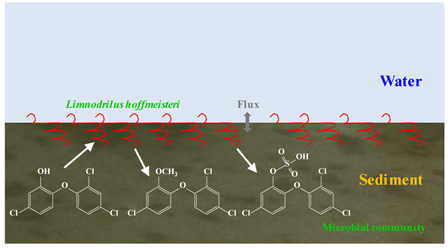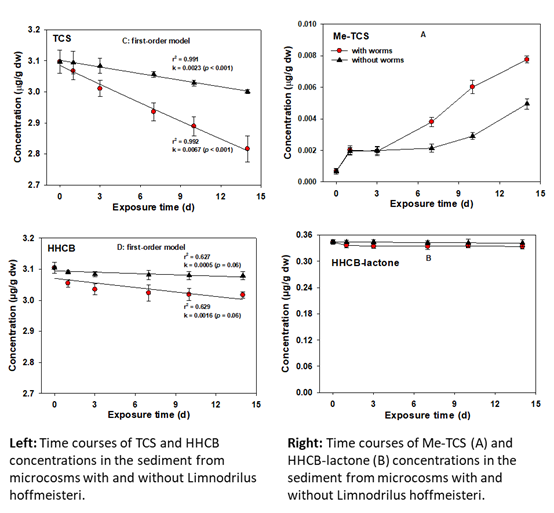Feng-Jiao Peng, a joint-PhD student of Professor Guang-Guo Ying (SERI) and Professor Paul van den Brink (Wageningen University), recently published a research article titled “Bioaccumulation and Biotransformation of Triclosan and Galaxolide in the Freshwater Oligochaete Limnodrilus hoffmeisteri in a Water/Sediment Microcosm” in Environmental Science & Technology. This research found that L. hoffmeisteri accelerated the dissipation of triclosan and galaxolide in a water/sediment microcosm and biotransformed triclosan into methyl triclosan and triclosan O-sulfate.

Triclosan and galaxolide are two common ingredients used in various personal care products. After use, these two chemicals are discharged through the down-the-drain route to wastewater treatment plants (WWTPs) where their removal is incomplete, thereby entering the aquatic environment via discharge of effluents. With their widespread use, incomplete removal and hydrophobic nature, these two chemicals have been frequently detected in river sediment. Despite this, previous studies on these chemicals mainly focused on their environmental behavior in water phase and microbial degradation, with less on the role of benthic organisms.

Peng et al. investigated bioaccumulation and biotransformation of two widely used personal care products, triclosan and galaxolide spiked to sediment, in the oligochaete worm Limnodrilus hoffmeisteri in water/sediment microcosms. They found that i) bioaccumulation of triclosan and galaxolide in L. hoffmeisteri reached equilibrium after 7 days of sediment exposure to 3.1 μg triclosan or galaxolide /g dry weight (dw) sediment, at which point the biota-sediment accumulation factors (BSAFs) were 2.07 and 2.50 for triclosan and galaxolide, respectively, ii) that the presence of L. hoffmeisteri significantly accelerated the dissipation of triclosan and galaxolide in the microcosms after 14 d exposure, and iii) that L. hoffmeisteri either cannot or has a very low ability to biodegrade galaxolide but can biotransform triclosan into methyl triclosan and triclosan O-sulfate through methylation and sulfation. The findings from this research show that hydrophobic personal care products in sediment can be dissipated through bioaccumulation and biotransformation of benthic organisms, and this can be a new important pathway for organic contaminants to degrade in sediment.
The published article is listed as follows:
Peng, F.-J.; Ying, G.-G.; Pan, C.-G.; Selck, H.; Salvito, D.; van den Brink, P., Bioaccumulation and biotransformation of triclosan and galaxolide in the freshwater oligochaete Limnodrilus hoffmeisteri in a water/sediment microcosm. Environ. Sci. Technol. 2018. DOI: 10.1021/acs.est.8b02637.